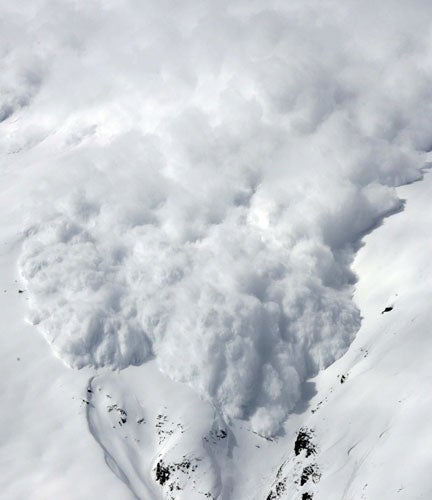Avalanche raises spectre of worst death toll in Alps for over 50 years

The search for the bodies of eight climbers swept down Mont Blanc du Tacul by a huge avalanche on Sunday morning was suspended all day yesterday because of the danger of provoking fresh slides.
The four Germans, three Swiss and one Austrian are presumed dead after the avalanche near western Europe's highest peak. The accident has brought the total number of deaths from avalanches in the Alps this year to 100, making it the worst year since 1970, which in turn was the worst since the "Winter of Terror" of 1951 when 200 climbers died.
"The area is very exposed to the falling of 'seracs' [towers of ice]," said Jean-Yves Claudon, a member of the local mountain rescue team. "There is no reason to put the lives of rescuers at risk for the sake of recovering the bodies. This is no longer an emergency situation."
Sunday's disaster was the biggest in what has been a tragic summer on the Alps. A serac the size of a four-storey building broke off near the summit of Mont Blanc du Tacul and, by the time the resulting avalanche hit dozens of climbers toiling up the slope in the hours before dawn, it was travelling at about 60mph. The fact that so many were rescued was "a miracle," according to a mountain gendarme at Chamonix, but even so this was the worst single avalanche disaster in the Alps since 1998.
Sunday's victims were doing nothing wrong, survivors insisted. Pamina Vitta, 29, one of nine Italians rescued, told the Italian newspaper La Stampa: "The expedition had been planned down to the smallest detail. There was no negligence. The avalanche descended on us and there was nothing we could do to avoid it."
Another survivor, Elena Cottini, said: "It was a terrible experience. Until that point the climb had gone beautifully. The mountain was enchanting, until the arrival of that executioner announced by a sort of creaking, like the breaking of a beam, then total darkness for several minutes. I thought I had been buried in the snow but when it was all over I found I could still breathe. 'I'm alive!' I told myself."
But while the climbers were guiltless, unlike the skiers and snowboarders who provoke winter avalanches, Jean-Marc Peillex, the mayor of Saint-Gervais, a village at the foot of Mont Blanc, blames the sheer popularity of the range for the rise in avalanche disasters this year. "It's madly overcrowded," he said.
He is campaigning for a limit on the number of people allowed on the slopes at any one time, "for the safety of people and of the environment". "Every summer 30,000 people climb the Mont Blanc range," he told La Stampa. "The refuges are at bursting point, the one at Gouter you literally can't get into." As a result, many climbers have to put up tents outside the refuges and sleep there. "Before taking their clients up Mont Blanc, guides should find out whether there is room in the refuges," said M. Peillex. "Instead of making their clients sleep on the ice and under canvas at 4,000m they should postpone the expedition." The endless lines of roped climbers going up and down the mountain during the summer months leads inevitably to more deaths, both from falls and from avalanches, he said.
Dr Jürg Schweizer, an avalanche specialist with the Swiss Federal Institute for Snow and Avalanche Research at Davos, said: "Icefall avalanches can happen any day in the summer, and summer climbers need to be more tuned in to them – they tend to be on the look- out for other hazards like rock falls." Winter avalanches cause injury by burying climbers, he said, but summer icefall avalanches kill by the impact of the ice, "which is not much different to being hit by a rock".
Icefalls "can happen any time of day or night" he added. "The best way to avoid them is to choose a route that is not exposed to too many seracs. In fact the traditional route up Mont Blanc du Tacul was abandoned, one reason being that it was far more exposed to icefalls than the one the climbers used on Sunday."
Deadly years on the slopes
* 1951: A three-month period that became known as the "Winter of Terror", during which 649 avalanches killed 265 people in Austria and Switzerland. Villages and thousands of acres of forests were destroyed.
* 1970: Thirty-nine people died and 37 were injured in February when an avalanche buried a chalet in Val d'Isére. Two months later, 74 more died, 56 of them children, when snow buried a sanatorium at Plateau d'Assy.
* 1998: Nine students and two guides were killed while snow-shoeing in the Alps. The group was blamed for setting off the winter avalanche.
* 1999: The village of Montrox, near Chamonix, was hit by an avalanche in February. Twelve people died and much of the village was destroyed. "Rounding a bend, I was greeted by a scene of utter devastation... Forest, buildings, pylons, all smashed and broken almost beyond recognition," said one eyewitness. In the same year, 39 people died in an avalanche in Val d'Isére. The high death toll was blamed on rampant development.
Join our commenting forum
Join thought-provoking conversations, follow other Independent readers and see their replies
Comments
Bookmark popover
Removed from bookmarks